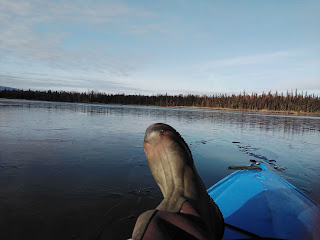October is the start of freeze up. This year, during the first half of October, snow started to cling to the apex of Mt. Susitna (about 4400 feet). On the 16th, it appeared at the top of Little Su, too (about 3300 feet). Most of the deciduous trees and bushes dropped their leaves (except for the yellow needles of tamaracks and the fat green maple-like leaves of the large domesticated currant bushes). We raked up tarps full of birch leaves to mulch the raised bed gardens as well as two trellises of domesticated raspberry bushes. We also re-wrapped the lowest 1-2 feet of young berry plants to protect them from under-snow girdling by hungry voles and hares. Having lost several prior apple and cherry trees to such predation, I hope we can finally outsmart those little rodents.
During the first half of the unusually warm month, we were still able to gather fresh salads of sorrel, mustard, and nasturtium greens every day. Tomatoes continued to grow in the greenhouse, even though I stopped watering in September. A wonderful treat was our first small harvest of horseradish. We divided the plants, cut the skinny horizontal roots for the kitchen and replanted the stronger, thicker tap roots for next year's growth. The ones I harvested for our use were so thin that I just used my thumb nail to scrape off the hairs and thin skin, then pulverized the roots with mayonnaise and yogurt for a tangy sauce. It was so delicious that it lasted a mere 2 weeks! I look forward to much more sauce in years to come, since the plant flourishes in our Alaska climate, and since our jalapenos seem to taste milder than those we grew in Texas.
By mid-month, the ground had firmed up as night time temperatures dropped to the upper 20's F and day time temperatures to the 30s F. We continued to kayak each afternoon (with extra layers) and measured mid-month water temperature, too, which dropped from 44 to 40 in two days.On the 15th, three river otters displayed their aquatic acrobatics in front of our dock – two large adults and a juvenile. In prior years, we have seen them only when ice has already formed on the surface of the water. Did they know something? Sure enough, two days later, we awoke to lacy ice floating over several acres of the lake. This state is attractive up close, especially in sunlight, like the edges of beveled glass windows crisscrossing layers. Water temperature near shore that day was 36 F. On the 16th, we heard the plaintive cries of a solo trumpeter swan swimming in circles in the middle of the lake. I surmised him to be a one year old. Did he lose his migrating family? We never see one alone. Also that day, we watched a wily and dexterous little weasel run out from beneath the roots of a birch tree to fallen fern fronds and then, by leaps and bounds, disappear up the path between raspberry bushes. He was already wearing his white winter coat. So all signs pointed to an imminent onset of winter. On the 18th, we awoke to the first white yard of the season, and on the 20th, most of the lake was covered by a thickening layer of clear ice. Our chickens do not like the cold and dark. In October, they departed the coop later in the mornings and entered it earlier in the evenings. Wouldn't you if you had bare legs? They can't scratch up the frozen soil, and their favorite plants have died back. Their bright orange egg yolks (from free-ranging all summer) shift to yellow during the winters when most of their calories come from purchased poultry feed. I supplement their winter diet with treats: fruit pulp and seeds, chicken bones and fat, barley, suet, peanut butter and leftovers. When their water bowls started to freeze, we dropped aquarium heaters into them. These look like luggage tags that plug in, drawing a lot less power than fully heated water bowls, but they work only down to temperatures in the teens. Still, any power saving implement is helpful because our solar and wind power systems are less useful in winter than summer.
Diminishing temperatures make our solar panels MORE effective but our battery bank for both power systems LESS effective. These two states balance each other during sunny shoulder season weather. We rev up the generator for a few hours only during periods of protracted rain, snow, or cloud cover. The rest of the time, we enjoy the quietude of solitude, punctuated by the occasional snap and pop of logs in the woodstove, which we started lighting several hours per day on Oct. 10.
My husband finally pronounced our wood corral FULL, at about 11 cords of birch and spruce, including two 4x4x4 cages full of tinder. I don't think he could have wedged in another branch. For quick retrieval, we stacked several days of spruce under the hot tub deck, and birch on metal shelving next to the back door for the cabin's woodstove.
Also around mid-month, we winterized the showerhouse and emptied the tanks of the on-demand water heater to the cabin. Instead, we top the woodstove with a 23 gallon aluminum water tank for convenient hot water and a bit of indoor humidity.
We have the good feeling that we accomplished all of the tasks we set for ourselves during our short, beautiful summer. During the next two months or so of freeze up, we can turn our attention to classes, hobbies, books, and activities that we save for this time of year.


No comments:
Post a Comment